A Vision of Sustainable Design Concepts for Upgrading Vulnerable Coastal Areas in Light of Climate Change Impacts: A Case Study from Beirut, Lebanon
Abstract
:1. Introduction
1.1. Rapid Urbanization and Growth of Informal Settlements
1.2. Background—Informal Settlements and Development
1.3. Climate Change Risks—Urban and Coastal Areas
1.4. Policies and Strategies—Urban and Coastal Areas
- Management and maintenance of sandy beaches all over the coast.
- Classification and protection of historical and natural sites located on the coastline.
- Emphasizing the high environmental value of certain parts of the Lebanese seashore.
- Preserving and developing the seaside promenades and the Corniche.
- Preserve the picturesque coastal towns of their important tourist value.
- Allow public access to the seashore and the use of the maritime public domain.
- Adopting several legislative steps against illegal construction.
- Command on the administrative, judicial and operational demarcation of the Lebanese coastal region.
- Establishment of the National Agency for Coastal Zone Management by the Council for Development and Reconstruction, the Ministry of Environment, the Ministry of Agriculture, the Ministry of Public Works, the Ministry of Public Works, and the General Directorate of Communities.
- Restrict land reclamation to strategic public utility projects by preparing and enforcing legislation and enforcing the implementation of Strategic Environmental Assessments (SEAs) and Environmental Impact Assessments (EIAs).
- Stop extracting sand from riverbeds, dunes, and beaches.
- Restricting the dumps overlooking the sea and rehabilitating the existing ones.
- Re-conversion of urban fallow areas to preserve natural coastal areas.
- Reducing intensive agricultural practices and monoculture in coastal areas.
1.5. Focusses and Aims
1.6. Paper Structure
2. Methodology
3. Aspects of Sustainability in the Context of Coastal Informal Settlements
4. Selected Interventions—International and Domestic Level
- -
- -
- Second, these interventions have adapted different sustainable techniques and innovations, through landscape, architecture, and urban design tools, which respond to similar needs and challenges to those of the Al-Ouzai/Jnah case that are addressed in Table 3. as findings based on the second study methods in this article (SWOT analysis). These findings focus on the three aspects of sustainability, in addition to the structural one that helped to understand the physical conditions of the settlement.
5. Case Study—Al-Ouzai/Jnah
5.1. Historical Background—Transformation
5.2. Interviews with Inhabitants and Observation
“We are very fully satisfied, we are close to all amenities, therefore we don’t need to travel to the city or elsewhere”
“Look at these sewerage canals, they are a huge disease-risk for the inhabitants of the area and it’s causing underground-water pollution”
“These bags of trash appeared as mountains because there is no “collecting garbage” service which the city should provide. To get to the bins, we need to walk from this spot approximately 15 min, however, the trash bins are always full, and nobody cares to collect it”
“Residents in this area are vulnerable to cardiovascular diseases. They are already exposed to be infected by respiratory diseases or lung cancer”
“I have a place to sleep, very close to the sea, when I arrived here, my cousin offered for me his rooftop to build a shelter, during stormy weather, waves crash directly on the walls of the houses lined up along the seafront. This creates a problem with dirty saltwater getting into living rooms and damaging furniture and possessions in most of the houses in line with mine”
“I sell Bananas here from morning to evening, this job is not the best, but I can collect some money at the end of the day to support my family”
“We don’t go to school, we usually spend our time here on the beach to support our family in fishing activity (dads and uncles), and at the end of the day, we sell a few kilos of fish. When we are tired, we go to the football field with friends”(Figure 6c,d).
“We spend most of the day in the inner alleys, they are our second home, we play football, eat sandwiches under the shade of the staircases and much more, they seem unsafe due to the flow of cars and motorcycles all day long and the absence of lighting at night”(Figure 6e).
“there are some open spaces in the area, however, they are not used efficiently, people think that those spaces are their property, and they randomly park their cars close to their living places”(Figure 6f).
5.3. SWOT Analysis
6. Results
6.1. Strategies and Speculative Vision towards Upgrading Actions for the Al-Ouzai/Jnah Settlement
6.1.1. Landscape Speculative Vision
- Sand dunes—the Geotextile sand tube method: artificially reconstructing sand dunes by collecting local sand into tubes with geo-textile layering and manually planting the dunes. The incorporation of the geotextile layer into tubes acts as a protective layer from possible polluted groundwater and the disturbed sand surface.
- Boardwalks merged with vegetation—floating on the sand dunes, offer a pleasant safe path along the shore.
- Rip rap stone—bridge foundations, steep slopes, and other shoreline structures to protect against scouring and erosion.
- Beach nourishment—for the northern part—a wider and higher beach can provide storm protection for coast structures, create new habitat and enhance the beach for recreation.
- Fishing docks—encourage fishing activity, by providing safer multifunction platforms for hook fishing.
- Flood defense wall—such structures protect areas of human habitation, conservation, and leisure activities from the action of tides, waves, and possibly even tsunamis, and protect the coast from erosion.
- Harbor regeneration—organize parking for fishing boats and yachts, provide a vivid area for social interaction and a transportation opportunity—improve the connection between zones located on the coast from the north to the south of Lebanon.
6.1.2. Architecture Speculative Vision
- Façades and balconies are refurbished and painted in bright colors.
- Degraded structures—rebuilt and expanded as required.
- Balconies and open roofs rich with greenery—encourage residents to practice urban farming activities and create a healthy environment.
- Buildings’ thresholds and circulation—cross ventilation is dramatically increased, creating an efficient solution to face a hot and humid climate during the summertime.
- Construction material—range across plastic, timber, brick, and concrete, available and suitable for the culture, climate, economy, density, and geography meet the basic criteria: low cost and easily transported.
6.1.3. Urban Design Speculative Vision
7. Discussion
8. Conclusions
Author Contributions
Funding
Institutional Review Board Statement
Informed Consent Statement
Conflicts of Interest
References
- United Nation. Department of Economic and Social Affairs. 2018. Available online: https://www.un.org/development/desa/en/news/population/2018-revision-of-world-urbanization-prospects.html (accessed on 18 January 2022).
- United Nations. Urban poor. In United Nations Climate Change; United Nations: New York, NY, USA, 2020. [Google Scholar]
- WHO. Population Living in Slums (% of Urban Population), United Nations Human Settlements Programme (UN-HABITAT). 2018. Available online: https://data.worldbank.org/indicator/EN.POP.SLUM.UR.ZS (accessed on 26 January 2022).
- Dodman, D.; Archer, D.; Mayr, M. Pro-Poor Climate Action in Informal Settlements; UN-Habitat: Nairobi, Kenya, 2018. [Google Scholar]
- Rojas, E. No time to waste; applying the lessons from Latin America’s 50 years of housing policies to rapidly urbanizing countries. Environ. Urban. 2018, 31, 177–192. [Google Scholar] [CrossRef]
- Worldometer. Lebanon Demographics. Available online: https://www.worldometers.info/demographics/lebanon-demographics/#pop. (accessed on 2 January 2022).
- Fawaz, M. Urban Policy: A Missing Government Framework; LCPS: Beirut, Lebanon, 2017. [Google Scholar]
- UN-Habitat. The Challenge of Slums, Global Report on Human Settlements 2003; Earthscan Publications Ltd.: London, UK, 2003. [Google Scholar]
- Satterthwaite, D.; Archer, D.; Colenbrander, S.; Dodman, D.; Hardoy, J.; Patel, S. Responding to Climate Change in Cities and in Their Informal; International Institute for Environment and Development: Edmonton, AB, Canada, 2018. [Google Scholar]
- Hassan, Z.; Francesca, G. Strategizing for Informal Settlements: The Case of Beirut; Faculty of Architecture and UrbanLAB, University of Belgrade: Belgrade, Serbia, 2018. [Google Scholar]
- Capri, E. Revisiting Vulnerability in a Slum of Beirut: When Citizenship Disempowers; CSKS: Beirut, Lebanon, 2015. [Google Scholar]
- Davis, M. Plants of Slums; Verso: London, UK, 2006. [Google Scholar]
- Henri, L. Le Droit à la Ville [The Right to the City]; Anthrops: Paris, France, 1968. [Google Scholar]
- Sclar, E.D.; Northridge, M.E. Slums, Slum Dwellers, and Health. Am. J. Public Health (AJPH) 2003, 93, 1381. [Google Scholar] [CrossRef] [PubMed]
- Mazorro, A.D.C. Understanding the History of Slums—Alejandro de Castro Mazarro; Columbia University and UN-Habitat: New York, NY, USA, 2016. [Google Scholar]
- The Government of Lebanon; The United Nations. The Lebanon Crisis Response Plan LCRB 2019 Update; UNHCR: Beirut, Lebanon, 2019.
- Jacobs, J. The Death and Life of Great American Cities (50th Anniversary Edition) (Modern Library), 50th ed.; Modern Library: New York, NY, USA, 2021. [Google Scholar]
- Gray, S.; Ocampo, M.N. Resilient Edges: Exploring a Socio-Ecological Urban Design Approach in Metro Manila. Plan J. 2017, 2, 519–561. [Google Scholar] [CrossRef]
- Hermanson, J.A. Slums, Informal Settlements and Inclusive Growth in Cities: Examples from Morocco and Colombia; IHC Global Coalition for Inclusive Housing and Sustainable Cities: Washington, DC, USA, 2015. [Google Scholar]
- Revi, A.; Satterthwaite, D.; Aragón-Durand, F.; Corfee-Morlot, J.; Kiunsi, R.B.R.; Pelling, M.; Roberts, D.; Solecki, W.; Pahwa Gajjar, S.; Sverdlik, A. Chapter 8: Urban Areas in Field. In Climate Change 2014: Impacts, Adaptation, and Vulnerability. Part A: Global and Sectoral Aspects; Cambridge University Press: Cambridge, UK, 2014. [Google Scholar]
- Satterthwaite, D.; Archer, D.; Colenbrander, S.; Dodman, D.; Hardoy, J.; Mitlin, D.; Patel, S. Building Resilience to Climate Change in Informal Settlements. One Earth 2020, 2, 143–156. [Google Scholar] [CrossRef] [Green Version]
- Satterthwaite, D.; Bartlett, S. Editorial: The full spectrum of risk in urban centres: Changing perceptions, changing priorities. Environ. Urban. 2017, 29, 3–14. [Google Scholar] [CrossRef] [Green Version]
- Ministry of Environment (MOE); United Nations Development Programme (UNDP). Climate Change: Vulnerability and Adaptation; United Nations Development Programme (UNDP): Beirut, Lebanon, 2011.
- Ministry of Environment (MOE). Lebanons Second National Communication to the United Nations Framework Convention on Climate Change; United Nations Development Programme (UNDP): Beirut, Lebanon, 2011.
- Ziervogel, G.; Pelling, M.; Cartwright, A.; Chu, E.; Deshpande, T.; Harris, L.; Hyams, K.; Kaunda, J.; Klaus, B.; Michael, K.; et al. Inserting rights and justice into urban resilience: A focus on everyday risk. Environ. Urban. 2017, 29, 123–138. [Google Scholar] [CrossRef] [Green Version]
- Porio, E. Climate Change Vulnerability and Adaptation in Metro Manila. J. Soc. Sci. 2014, 42, 75–102. [Google Scholar] [CrossRef]
- Núñez Collado, J.R.; Wang, H.H. Slum upgrading and climate change adaptation and mitigation: Lessons from Latin America. Cities 2020, 104, 102791. [Google Scholar] [CrossRef]
- Archer, D. Finance as the key to unlocking community potential: Savings, funds and the ACCA programme. Environ. Urban. 2012, 24, 423–440. [Google Scholar] [CrossRef]
- Council for Development and Reconstruction (CDR). National Physical Master Plan for the Lebanese; CDR: Beirut, Lebanon, 2005. [Google Scholar]
- Pojani, D. The self-built city: Theorizing urban design of informal settlements. IJAR Int. J. Archit. Res. 2019, 13, 294–313. [Google Scholar] [CrossRef]
- Jorgensen, B.S.; Stedman, R.C. Sense of place as an attitude: Lakeshore owners attitudes toward their properties. J. Environ. Psychol. 2001, 21, 233–248. [Google Scholar] [CrossRef]
- Loomiss, D.K.; Paterson, S.K. The human dimensions of coastal ecosystem services: Managing for social values. Ecol. Indic. 2014, 44, 6–10. [Google Scholar] [CrossRef]
- 15 Wonderful Facts About the Mediterranean Sea. Available online: https://15facts.com/about-the-mediterranean-sea/ (accessed on 19 July 2021).
- Kostopoulou, S. On the Revitalized Waterfront: Creative Milieu for Creative Tourism. Sustainability 2013, 5, 10–16. [Google Scholar] [CrossRef] [Green Version]
- Neumann, B.; Ott, K.; Kenchington, R. Strong sustainability in coastal areas: A conceptual interpretation of SDG 14. Sustain. Sci. 2017, 12, 1019–1035. [Google Scholar] [CrossRef] [PubMed] [Green Version]
- Harrison, S. Keast Park Community Pavilion; Architectureau: Seaford, VIC, Australia, 2012; Available online: https://www.archdaily.com/321636/keast-park-community-pavilion-jackson-clements-burrows-architects (accessed on 3 February 2021).
- Turenscape. The Qinhuangdao Beach Restoration: An Ecological Surgery; Wold-Architect: Qinhuangdao, China, 2008; Available online: https://www.world-architects.com/en/turenscape-haidian-district-beijing/project/qinhuangdao-beach-restoration-an-ecological-surgery (accessed on 23 December 2020).
- Bitan, M.; Zviely, D. Sand Beach Nourishment: Experience from the Mediterranean Coast of Israel. Mar. Sci. Eng. 2020, 8, 273. [Google Scholar] [CrossRef] [Green Version]
- Jáuregui, J.M. Manguinhos Complex; RIL: Rio de Janeiro, Brazil, 2005; Available online: http://www.jauregui.arq.br/broken_city.html (accessed on 23 July 2021).
- UNRWA. Reconstruction of Nahr el-Bared Refugee Camp; HersKhazeen: Tripoli, Lebanon, 2011; Available online: http://www.herskhazeen.com/reconstruction-of-nahr-el-bared-refugee-camp/ (accessed on 23 May 2021).
- UN-Habitat; UNICEF. Old Saida Neighbourhood Profile 2019; UN-Habitat Lebanon: Beirut, Lebanon, 2019. [Google Scholar]
- ETH Studio. “Dahiyah” The South-Western Suburbs of Beirut; ETH Studio: Beirut, Lebanon, 2009. [Google Scholar]
- Sabra, J.; Imad, R.; Miri, H.; Yehia, Y.; Al-Zein, M.S. Restoration against all odds: The case of coastal sand dunes in Ouzai. Ecol. Plant Med. 2017, 54, 6–12. [Google Scholar]
- EJA. Costa Brava Landfill, Lebanon|EJAtlas. 2 July 2017. Available online: https://ejatlas.org/conflict/costa-brava-landfill-lebanon (accessed on 12 November 2021).
- Zeitoun, A. Saint Simon, Ouzai. 5 June 2011. Available online: https://www.mashallahnews.com/saint-simon-ouzai/ (accessed on 15 October 2021).
- The World Bank Group. What is Urban Upgrading? In Upgarding Urban Communities—A Resourse Framework; MIT: Cambridge, MA, USA, 2001. [Google Scholar]
- Ruppert, R. Beyrouth, une Ville D’orient Marquée Par L’occident [Beirut, an Eastern City Marked by the West]; Presses de l’Ifpo: Beirut, Lebanon, 1999. [Google Scholar]
- Fawaz, M.; Peillen, I. The Case of Beirut Lebanon; UCL: Beirut, Lebanon, 2003. [Google Scholar]
- Jaitman, L.; Brakarz, J. Evaluation of Slum Upgrading Programs Literature Review and Methodological Approaches; Inter-American Development Bank (IDP): Washington, DC, USA, 2013. [Google Scholar]
- Satterthwaite, D. Upgrading Slums: With and For Slum-Dwellers. JSTOR 2010, 45, 12–16. [Google Scholar]
- United Nations Human Settlements Programme (UN-Habitat). Habitat Country Programme Document Lebanon 2021–2023; UN-Habitat: Beirut, Lebanon, 2021. [Google Scholar]
- United Nations Human Settlements Programme (UN-Habitat). Fostering Hope in El Jazzar Street Sabra Beirut by Improved Living Conditions; UN-HABITAT FOR A BETTER URBAN FUTUR: Beirut, Lebanon, 2021; Available online: https://unhabitat.org/fostering-hope-in-el-jazzar-street-sabra-beirut-by-improved-living-conditions (accessed on 5 January 2022).
- Futurecapetown. Ten Cities Tackling Climate Change; Smart Cities Dive: Washington, DC, USA, 2017; Available online: https://www.smartcitiesdive.com/ex/sustainablecitiescollective/10-cities-tackling-climate-change/178136/ (accessed on 15 December 2021).
- Omar, O.; Azab, A. Ouzai Road Slums An exploratory study for social and environmental Problems. In Proceedings of the 1st International Conference on Urban Health & Wellbeing Uhwb2018 Building Collaborative Intelligence for Better Lives in Cities, Beirut, Lebanon, 23–25 October 2018; UHWB: Beirut, Lebanon, 2018. [Google Scholar]
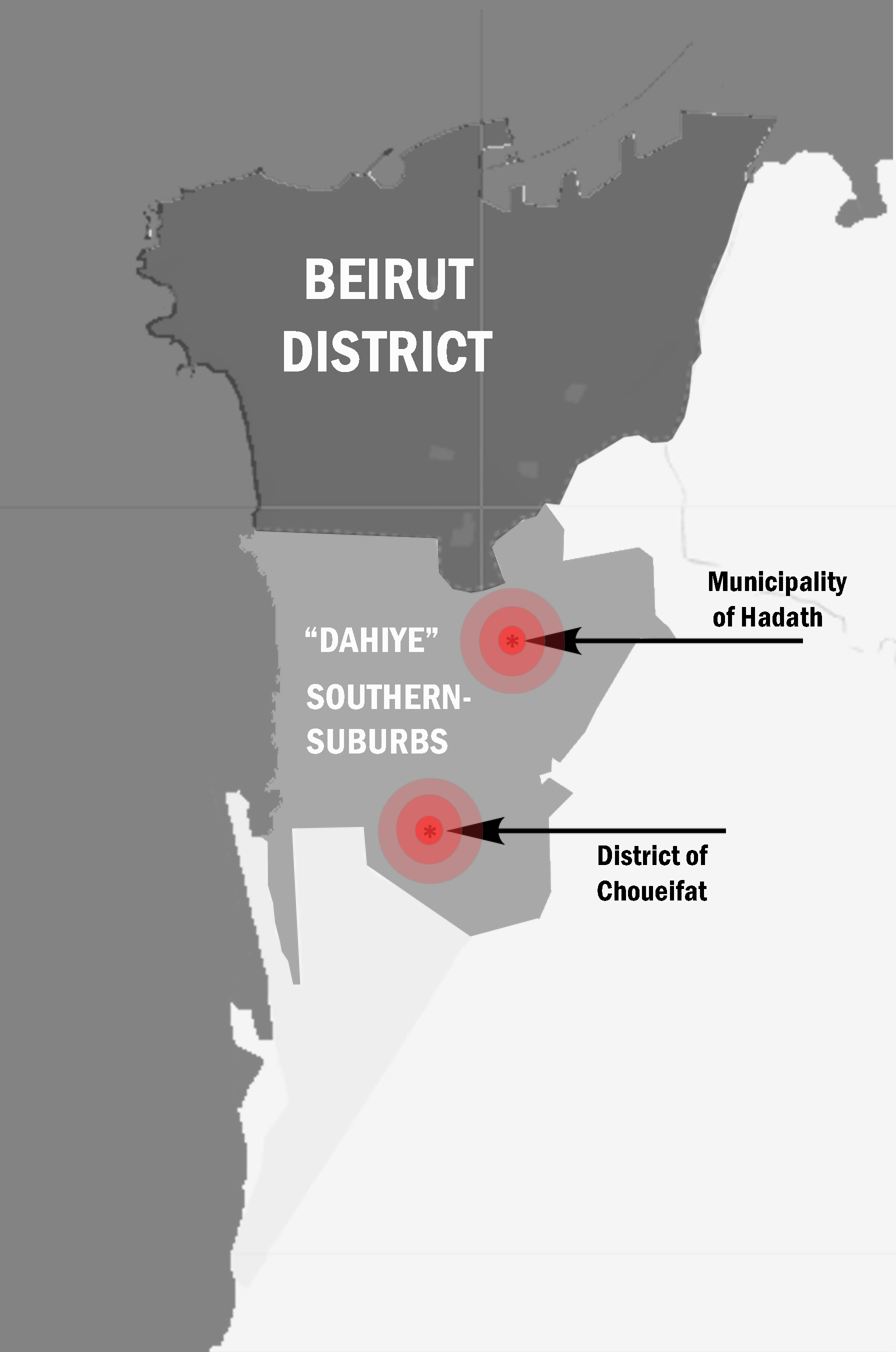
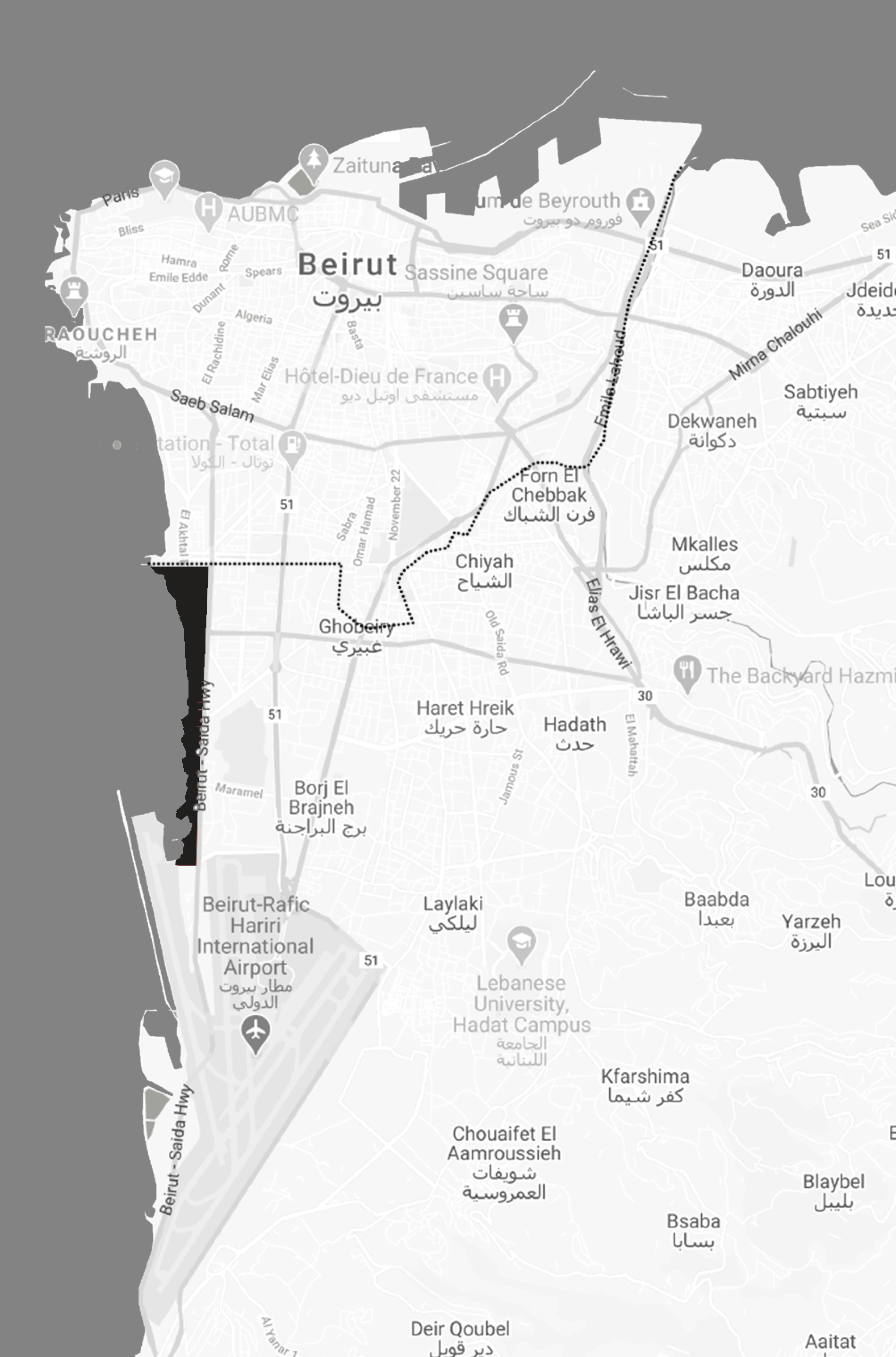
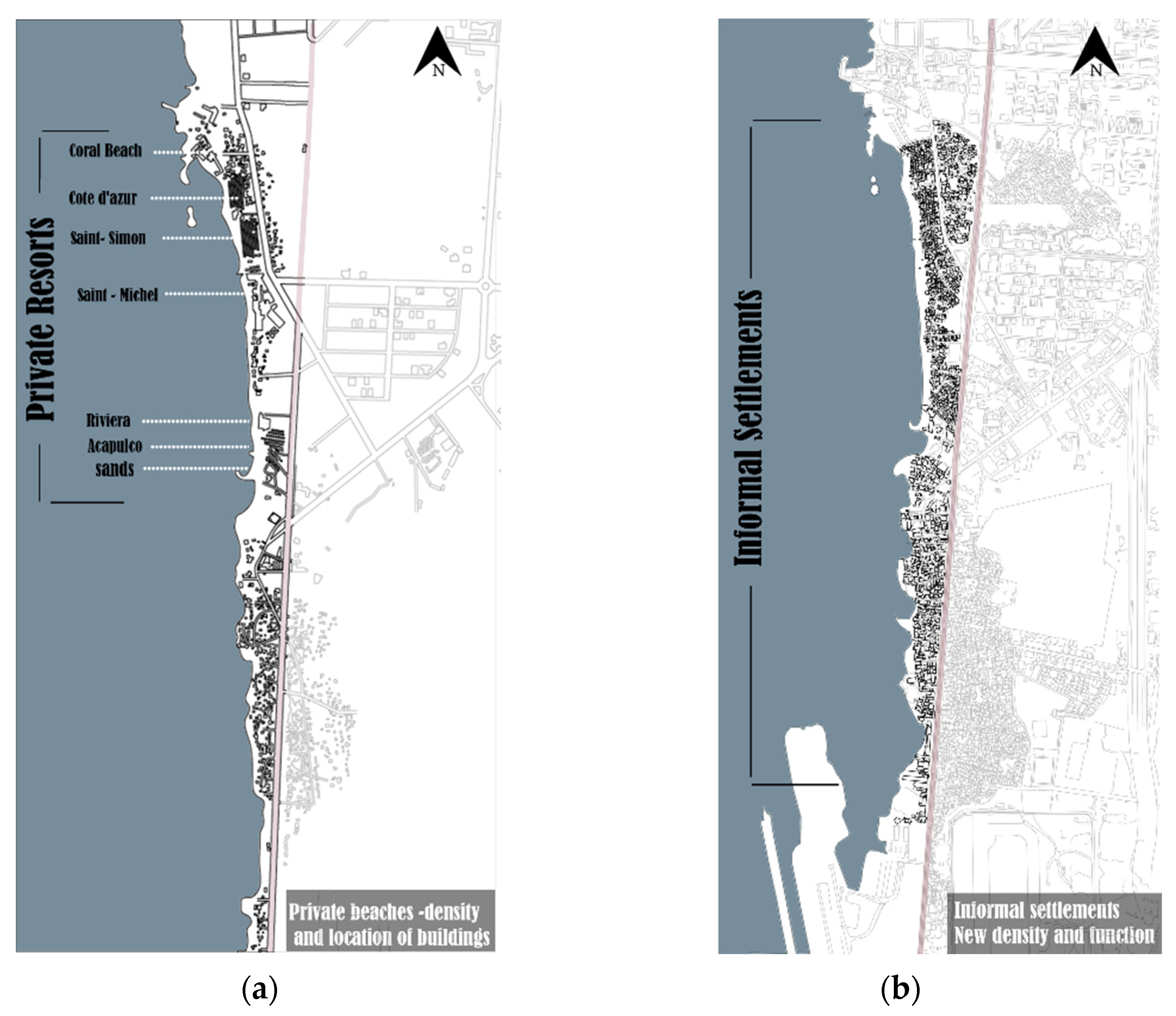
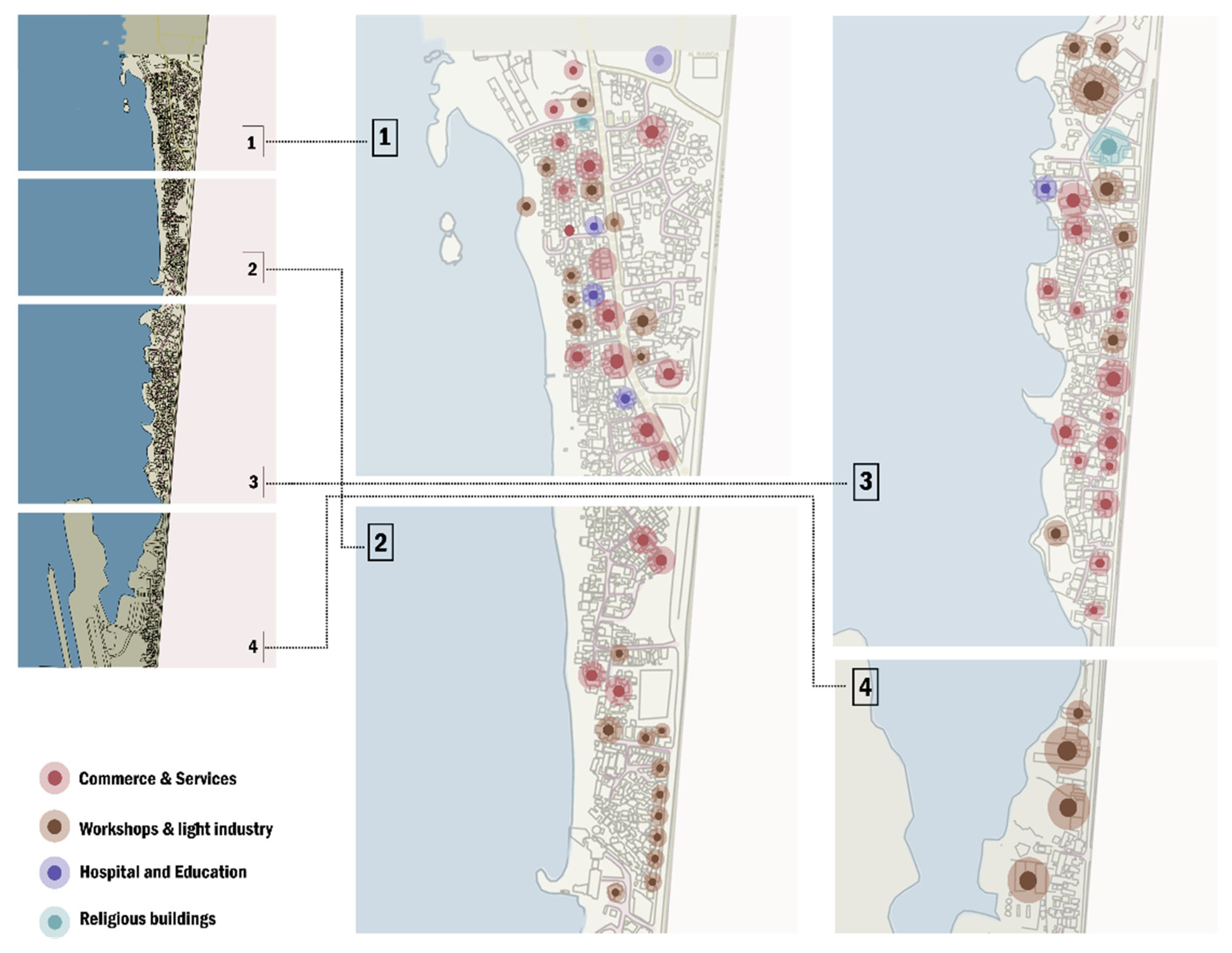
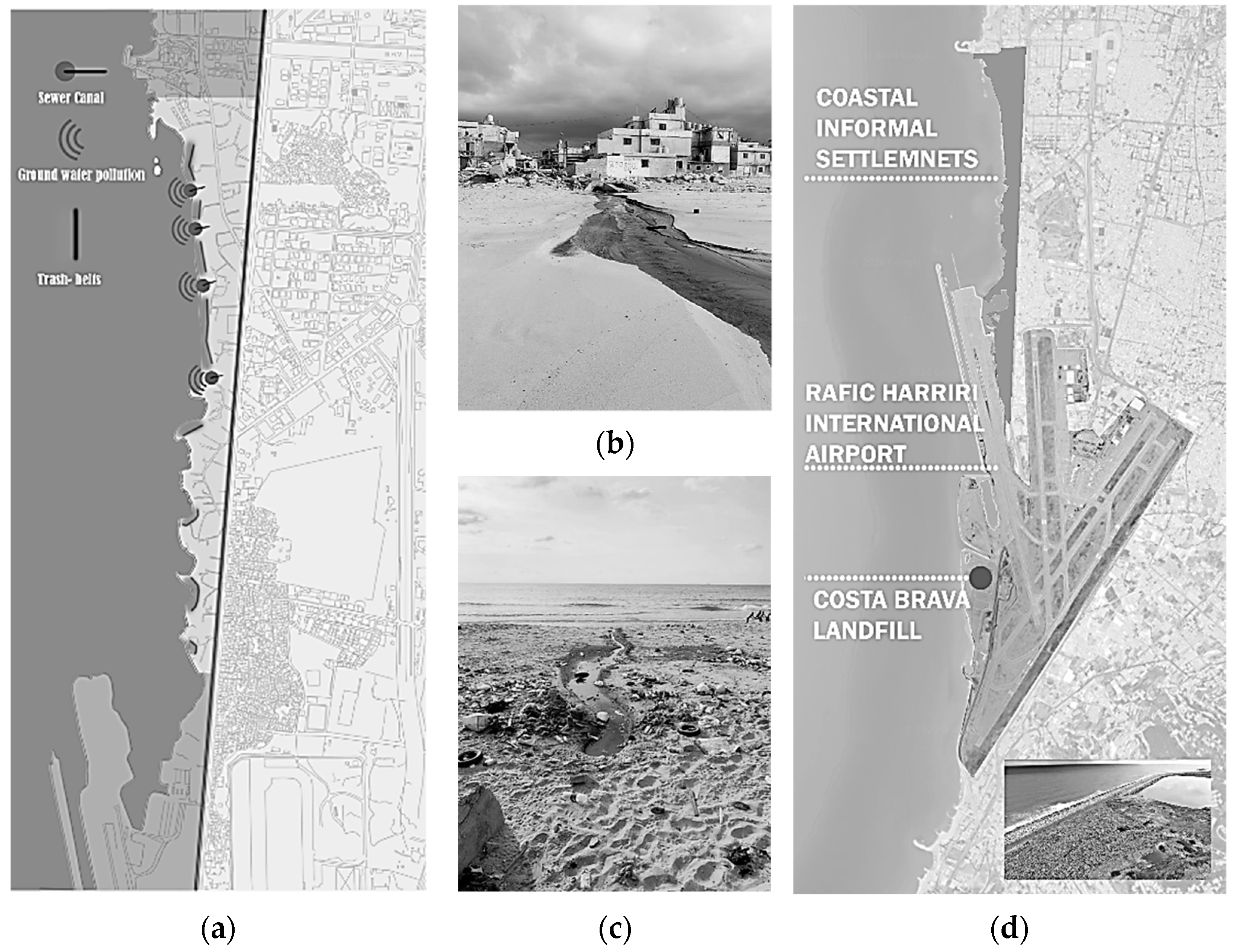
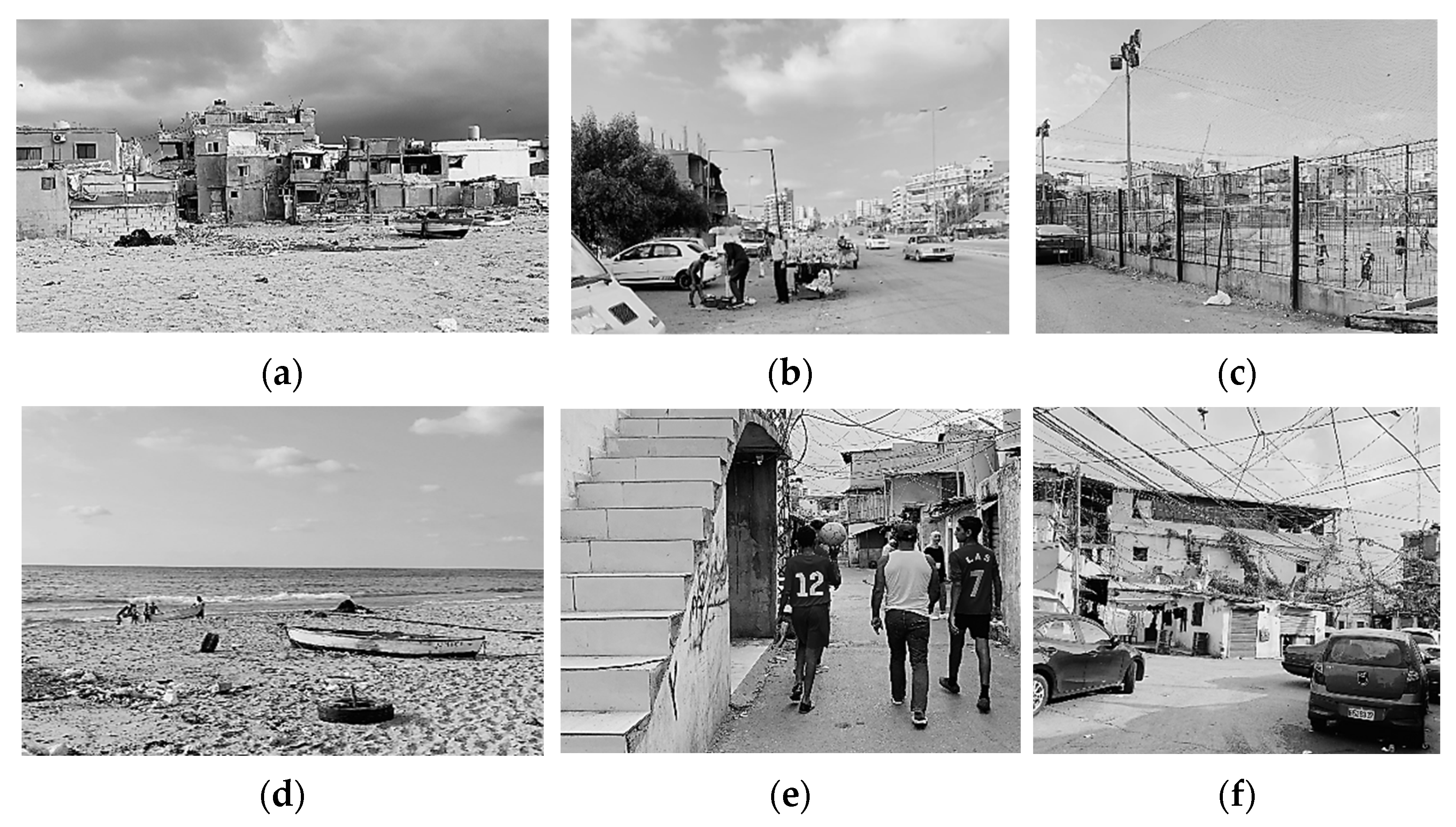
| Group 1 | ||||
|---|---|---|---|---|
| Project | Action | Techniques | Results | Factor Achieved |
| Keast Park—(Australia) [36]. | Transformation from coastal dune to the built environment | Boardwalk that protects the restored dune landscape. Green spaces—park and meeting areas. Outdoors installations for community physical activities | Explores the integration and overlap of multiple community facilities and activities, promotes a stronger sense of community ownership and engagement. Transformation from passive to active spaces took place. | Environmental Social |
| Qinhuangdao Beach Transformation—(China) [37]. | Rehabilitation of damaged natural environment | Arranging a boardwalk that winds along the shoreline, linking different patches of plant communities, it also functions as a soil conservation installation that protects the shoreline from the erosion caused by the ocean wind and waves Eco-friendly bases were designed using fiberglass and riprap technique that allows the boardwalk to “float” above the dunes and wetland. | Rehabilitation of the damaged natural environment restored and unveiled the beauty of the site to tourists and local residents. Transformation of a former degraded beach into an ecologically healthy and aesthetically attractive landscape Facilitates the initiatives of rebuilding a harmonious relationship between man and nature through ecological design | Environmental Social |
| Coastline Nourishment, Ashdod Port-Ashkelon Marina—Haifa Bay—(Israel) [38]. | Mitigation of coastal erosion, displacement of sand to threatened beaches. | Placement of sand on the eroded shore to maintain the amount of sand present in the foundation of the coast to protect the area against storms. The process involves dredging material (sand, pebbles) from a source area (offshore or inland) to feed the beach where erosion is occurring | Representation of a new approach to mitigating coastal erosion by adding suitable sand to threatened beaches Maintains the width of beaches for tourism and recreational purposes. | Environmental Social Economic |
| Group 2 | ||||
|---|---|---|---|---|
| Project | Action | Techniques | Results | Factors Achieved |
| Manguinhos Complex. Rio de Janeiro—(Brazil) [39]. | Regeneration, building new network and facilities | Offering new social facilities, civic center including school, library, legal support office and squares Building the “Manguinhos” train station | Creation of the new “Rambla” connective space Re-qualification of broken city with new facilities. Public spaces for social interaction Satisfaction of different age groups, including sport, culture, and job opportunities. | Environmental Social Economic Architectural |
| Reconstruction of Nahr El-Bared Refugee Camp—(Lebanon) [40]. | Reconstruction of destroyed camp | Rebuilding dwellers’ homes, commercial services, mosques. Implementing new infrastructure. Offering new public spaces and green areas. Rebuilding local health clinics Recreating physical and social fabrics were primary considerations. Workshops organized with encouragement from the municipality | New working relationships with the community, the Lebanese government, and various local and international stakeholders Increased sense of belonging and community responsibility. Social interaction (resilient community) | Environmental Social Economic Architectural |
| Rehabilitation of Old Saida residential neighborhood—(Lebanon) [41]. | Rehabilitation of historical neighborhood—vulnerable urban areas | Alleviating poor housing conditions for vulnerable families (host and refugee) Protecting historic buildings from physical damage or destruction Securing and improving livelihood opportunities within neighboring markets Rebuilding infrastructure | Increased awareness within the community about the importance of cultural heritage sites Created sufficient access to basic urban services in the neighborhood | Social Economic |
| SWOT Analysis | ||||
|---|---|---|---|---|
| Factors | Strengths | Weaknesses | Opportunities | Threats |
| Environmental | The coastal zone can be used as a way to reduce heat in inland urban areas. | Household waste and garbage bags create a kind of border between the sea and the settlements. The infrastructure is in bad condition, which reflects directly on the environment by rainwater flooding in winter seasons. The absence of a garbage collection service. The sewage canals produced by the settlements, run throughout the entire neighborhood until the sea, through concrete canals, which form pools of stagnant sewage along the shore, which constitutes a major disease-risk factor for the inhabitants of the area and affects ground-water pollution. The spread of cardiovascular diseases, dwellers are exposed to pollutants and infected by respiratory diseases or lung cancer, due to the proximity of the area to Rafic Hariri International Airport (aircraft emissions) and the Costa Brava landfill, promoted as a temporary solution to the trash crisis that Lebanon suffered in 2015. | Beach nourishment, flood defense wall, dunes, rip rap technique, boardwalk merged with vegetation Encouraging urban farming can reduce greenhouse gas emissions associated with transportation and biodiversity. | Rising temperatures, rising sea levels, heavy precipitation (heavy rain and hail), degradation of the shore, strong floods might cause the death of residents and completely destroy the settlement structure. |
| Social | People stay within a close radius of their house, as relatives and friends live in proximity (sense of unity). | Minors work illegally all over the city, in such jobs as automobile service and furniture design workshops, electronics stores and hairdressers, and even small restaurants and cafes. Kids play under sunshades, on the streets with little traffic. Absence of judicial and security procedures. Low level of education. | Provide training programs to increase local skills. Empowering women by involving them in economic activities (providing job opportunities) Build an engaged community by involving the in the development process (sense of responsibility and awareness) Encouraging children and adolescents to enroll in schools and universities by providing workshops aimed at raising awareness as well as promoting the facilities and services that will be provided by the Transformation Program (Safe and pleasant Connection through Streets) | Human loss due to outbreaks of crime due to poverty and low security. In addition to the outbreaks of epidemics due to pollution and poor health conditions. Social isolation that threatens mental health |
| Economic | Commercial facilities are located along the Beirut-Saida highway. The shops include car parts sales and car repairs, office furniture, bathroom, and kitchen fitters, electronic services, and hairdressers. Street vendors sell fruits and vegetables on the Ouzai Boulevard highway, which also benefits strangers, and drivers passing by. Some dwellers depend on fishing activity as a source of income, using old wooden boats, which are always left randomly on the beach for the next working day. | Illegal and unregistered business. Unsafe work for minors. Lack of diversity in work and relationships on a larger scale. Limited skills in using innovative tools. Low-incomes for families. | Economic development for the sector through the development of the coastline and the main commercial spine. Boasting tourism in the coastal zone. | |
| Structural | The settlement is located in a strategic location at the southern edge of Beirut—in the middle coastal area of the country. The area has an excellent external road network and accessibility with national roads and the Beirut-Saida highway. Proximity to the Rafic Hariri International airport. Proximity to wealthy urban and other coastal areas. The settlement hosts a variety of service buildings and public institutions, such as workshop places, schools, and hospitals, which are spread throughout the whole site in medium conditions. Availability of religious places in the area. As the majority of the inhabitants are Shiites, most of the mosques in the areas exist in good condition satisfying their needs. From the mobility point of view, the inhabitants of the area do not rely on cars much as all services are available in the settlement or the close neighborhood. | Poor technical condition of the infrastructure, buildings conditions are a major threat to public safety, as most homes that suffer from cracks are threatened with collapse. Poor construction material. Poor structure systems. Absence of public spaces and green areas. Absence of natural lighting and ventilation. Traffic jams by the commercial entities. Irregular inner networks, poor quality of the inner road networks. Absence of infrastructure for rain drainage, lighting, and traffic signs. Lack of organized parking, many cars are parked alongside the streets, the most common vehicles are scooters and motorbikes, with many taxis, and small buses are driving around. The beach is not used for recreation in the way somebody acquainted with tourism would expect. | Rethink the role of the informal settlements in the urban spaces. Take advantage of the coastal area by merging upgrading and climate change adaptation and mitigation actions. View the urban development of the case study as creative action. Consider sustainable solutions as crucial aspects in the development. | The area will be at high risk of natural disasters. Human losses caused by poor structures (falling). The neighborhood appeared as a neglected urban structure. |
Publisher’s Note: MDPI stays neutral with regard to jurisdictional claims in published maps and institutional affiliations. |
© 2022 by the authors. Licensee MDPI, Basel, Switzerland. This article is an open access article distributed under the terms and conditions of the Creative Commons Attribution (CC BY) license (https://creativecommons.org/licenses/by/4.0/).
Share and Cite
Wojtowicz-Jankowska, D.; Bou Kalfouni, B. A Vision of Sustainable Design Concepts for Upgrading Vulnerable Coastal Areas in Light of Climate Change Impacts: A Case Study from Beirut, Lebanon. Sustainability 2022, 14, 3986. https://doi.org/10.3390/su14073986
Wojtowicz-Jankowska D, Bou Kalfouni B. A Vision of Sustainable Design Concepts for Upgrading Vulnerable Coastal Areas in Light of Climate Change Impacts: A Case Study from Beirut, Lebanon. Sustainability. 2022; 14(7):3986. https://doi.org/10.3390/su14073986
Chicago/Turabian StyleWojtowicz-Jankowska, Dorota, and Bahaa Bou Kalfouni. 2022. "A Vision of Sustainable Design Concepts for Upgrading Vulnerable Coastal Areas in Light of Climate Change Impacts: A Case Study from Beirut, Lebanon" Sustainability 14, no. 7: 3986. https://doi.org/10.3390/su14073986
APA StyleWojtowicz-Jankowska, D., & Bou Kalfouni, B. (2022). A Vision of Sustainable Design Concepts for Upgrading Vulnerable Coastal Areas in Light of Climate Change Impacts: A Case Study from Beirut, Lebanon. Sustainability, 14(7), 3986. https://doi.org/10.3390/su14073986







